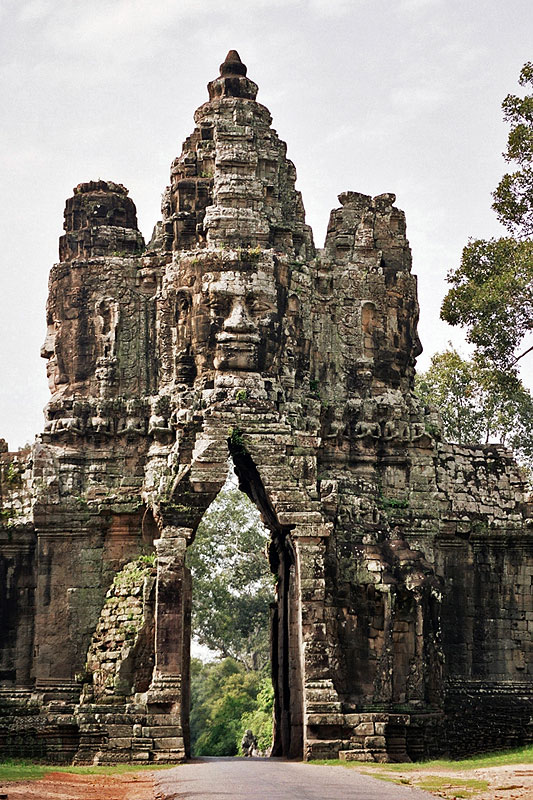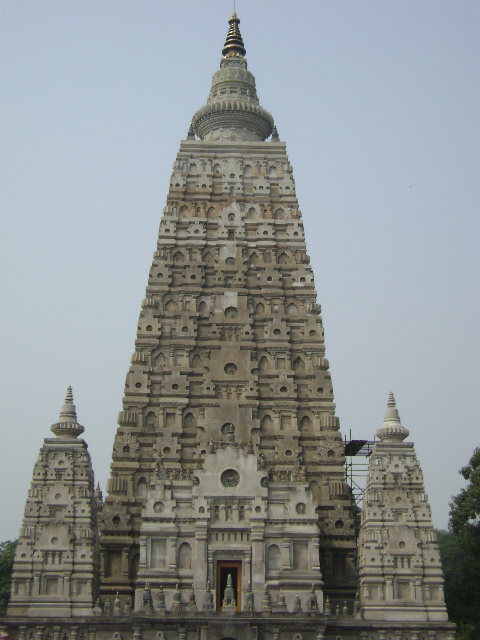|
Bakheng
Phnom Bakheng ( km, ភ្នំបាខែង ) is a Hindu and Buddhist temple in the form of a temple mountain in Siem Reap Province, Cambodia. Dedicated to Shiva, it was built at the end of the 9th century, during the reign of King Yasovarman (889-910). Located atop a hill, it is nowadays a popular tourist spot for sunset views of the much bigger temple Angkor Wat, which lies amid the jungle about 1.5 km to the southeast. The large number of visitors makes Phnom Bakheng one of the most threatened monuments of Angkor. Since 2004, World Monuments Fund has been working to conserve the temple in partnership with APSARA. History Constructed more than two centuries before Angkor Wat, Phnom Bakheng was in its day the principal temple of the Angkor region, historians believe. It was the architectural centerpiece of a new capital, Yasodharapura, that Yasovarman built when he moved the court from the capital Hariharalaya in the Roluos area located to the southeast. An inscri ... [...More Info...] [...Related Items...] OR: [Wikipedia] [Google] [Baidu] |
Phnom Bok
Phnom Bok ( km, ភ្នំបូក) is a hill in the northeast of Eastern Baray in Cambodia, with a prasat (temple) ( km, ប្រាសាទភ្នំបូក) of the same name built on it. It is one of the "trilogies of mountains", each of which has a temple with similar layout. The creation of the temple is credited to the reign of Yasovarman I (889–910)Higham, C., 2001, The Civilization of Angkor, London: Weidenfeld & Nicolson, between 9th and 10th centuries; established after he moved his capital to Angkor and named it Yasodharapura. The two other sister temples, named after the contiguous hills, are the Phnom Bakheng and Phnom Krom. The site of the three hills was chosen by Yashovarman I along with the Eastern Baray (where only the base of the central shrine is surviving). In the 10th century, these shrines had high religious value during the Angkorian rule. The temples called as part of an "architectural triad" brought about an element of experimentation in a ... [...More Info...] [...Related Items...] OR: [Wikipedia] [Google] [Baidu] |
Yasovarman I
Yasovarman I ( km, ព្រះបាទយសោវរ្ម័នទី១) was an Angkorian king who reigned in 889–910 CE. He was called " Leper King". Early years Yasovarman was a son of King Indravarman I and his wife Indradevi. Yaasovarman was said to be a wrestler. Inscriptions say he was capable of wrestling with elephants. The inscriptions also say he was capable of slaying tigers with his bare hands. His teacher was the '' purohit'' Brahman Vamasiva, part of the Devaraja cult priesthood. Vamasiva's guru, Sivasoma, was connected to the Hindu philosopher Adi Shankara. After the death of Indravarman, a succession war was fought by his two sons, Yasovarman and his brother. It is believed that the war was fought on land and on sea by the Tonlé Sap. In the end Yasovarman prevailed. Because of his father had sought to deny his accession, according to inscriptions cited by L.P. Briggs, "Yasovarman I ignored his claim to the throne through his father, Indravar ... [...More Info...] [...Related Items...] OR: [Wikipedia] [Google] [Baidu] |
Angkor Phnom Bakheng アンコール・プノンバケン DSCF4155
Angkor ( km, អង្គរ , 'Capital city'), also known as Yasodharapura ( km, យសោធរបុរៈ; sa, यशोधरपुर),Headly, Robert K.; Chhor, Kylin; Lim, Lam Kheng; Kheang, Lim Hak; Chun, Chen. 1977. ''Cambodian-English Dictionary''. Bureau of Special Research in Modern Languages. The Catholic University of America Press. Washington, D.C. Chuon Nath Khmer Dictionary (1966, Buddhist Institute, Phnom Penh). was the capital city of the Khmer Empire. The city and empire flourished from approximately the 9th to the 15th centuries. The city houses the Angkor Wat, one of Cambodia's most popular tourist attractions. The name ''Angkor'' is derived from ''nokor'' (), a Khmer word meaning "kingdom" which in turn derived from Sanskrit ''nagara'' (), meaning "city". The Angkorian period began in AD 802, when the Khmer Hindu monarch Jayavarman II declared himself a "universal monarch" and "god-king", and lasted until the late 14th century, first falling under ... [...More Info...] [...Related Items...] OR: [Wikipedia] [Google] [Baidu] |
Hariharalaya
Hariharalaya ( km, ហរិហរាល័យ, Hariharalay) was an ancient city and capital of the Khmer empire located near Siem Reap, Cambodia in an area now called Roluos ( Khmer: រលួស). Today, all that remains of the city are the ruins of several royal temples: Preah Ko, the Bakong, Lolei.Higham, C., 2001, The Civilization of Angkor, London: Weidenfeld & Nicolson, Higham, C., 2014, Early Mainland Southeast Asia, Bangkok: River Books Co., Ltd., Etymology The name "Hariharalaya" is derived from the name of Harihara, a Hindu deity prominent in pre-Angkorian Cambodia. The name "Harihara" in turn is a composite of "Hari" (one of Vishnu's names listed in Vishnu sahasranama) and "Hara" (meaning the Hindu god Shiva). Cambodian representations of Harihara were of a male deity whose one side bore the attributes of Vishnu and whose other side bore the attributes of Shiva. For example, the deity’s head-covering consisted of a mitre-type hat (the attribute of Vishnu) o ... [...More Info...] [...Related Items...] OR: [Wikipedia] [Google] [Baidu] |
Sdok Kak Thom
Sdok Kok Thom ( th, สด๊กก๊อกธม, ''Sadok Kok Thom'', ; km, ស្តុកកក់ធំ, ), or Sdok Kak Thom, is an 11th-century Khmer temple in present-day Thailand, located about northeast of the Thai border town of Aranyaprathet. The temple is in Khok Sung District, Sa Kaeo Province, near the village of Ban Nong Samet. It is regarded as the largest Khmer temple in eastern Thailand. The temple was dedicated to the Hindu god Shiva. Constructed by a prominent priestly family, Sdok Kok Thom is best known as the original site of one of the most illuminating inscriptions left behind by the Khmer Empire, which ruled much of Southeast Asia from the end of the 9th century to the 15th century. Built of red sandstone and laterite, the temple is a prime example of a provincial seat of worship during the empire's golden age. It is small by the standards of the major monuments in Angkor, the empire's capital, but shares their basic design and religious symbolism. ... [...More Info...] [...Related Items...] OR: [Wikipedia] [Google] [Baidu] |
Phnom Krom
Phnom Krom ( km, ភ្នំក្រោម, lit. "downstream hill") is a 140 m high hill close to Siem Reap city, Cambodia. There is a temple on the top which derived its name from the hill, Prasat Phnom Krom ( km, ប្រាសាទភ្នំក្រោម). Location Phnom Krom is about 12 kilometers southwest of Siem Reap town. Phnom Krom hill is very rocky; local legend has it that the rocks were exposed by the monkey general Hanuman during a hunt for medicine in the Ramayana epic. The area beyond the temple’s west gate affords views of the Tonle Sap lake. Phnom Krom railway Phnom Krom was at the southern end of the Phnom Krom railway, a narrow-gauge French colonial railway that was most likely constructed to take stone from the now-defunct quarries on Phnom Krom to Siem Reap. Gallery File:Pier at Phnom Krom, Siem Reap - panoramio.jpg, Tonle Sap lake and Phnom Krom hill File:Blick vom Phnom Krom 03.jpg, Tonle Sap lake and Chong Kneas village viewed from Phn ... [...More Info...] [...Related Items...] OR: [Wikipedia] [Google] [Baidu] |
World Monuments Fund
World Monuments Fund (WMF) is a private, international, non-profit organization dedicated to the preservation of historic architecture and cultural heritage sites around the world through fieldwork, advocacy, grantmaking, education, and training. Founded in 1965, WMF is headquartered in New York, and has offices and affiliates around the world, including Cambodia, France, Peru, Portugal, Spain, and the United Kingdom. In addition to hands-on management, the affiliates identify, develop, and manage projects, negotiate local partnerships, and attract local support to complement funds provided by donors. History International Fund for Monuments (1965–1984) The ''International Fund for Monuments'' (IFM) was an organization created by Colonel James A. Gray (1909–1994) after his retirement from the U.S. Army in 1960. Gray had conceived of a visionary project to arrest the settlement of the Leaning Tower of Pisa by freezing the soil underneath, and formed the organization in ... [...More Info...] [...Related Items...] OR: [Wikipedia] [Google] [Baidu] |
List Of Archaeoastronomical Sites By Country
This is a list of sites where claims for the use of archaeoastronomy have been made, sorted by country. The International Council on Monuments and Sites (ICOMOS) and the International Astronomical Union (IAU) jointly published a thematic study on heritage sites of astronomy and archaeoastronomy to be used as a guide to UNESCO in its evaluation of the cultural importance of archaeoastronomical sites around the world, which discussed sample sites and provided categories for the classification of archaeoastronomical sites. The editors, Clive Ruggles and Michel Cotte, proposed that archaeoastronomical sites be considered in four categories: 1) Generally accepted; 2) Debated among specialists; 3) Unproven; and 4) Completely refuted. Armenia * Zorats Karer (aka Carahunge), archeological site claimed to have astronomical significance although this is disputed. it is often referred to in international tourist lore as the "Armenian Stonehenge". Australia * Ngaut Ngaut oral tradition say ... [...More Info...] [...Related Items...] OR: [Wikipedia] [Google] [Baidu] |
Buddhist
Buddhism ( , ), also known as Buddha Dharma and Dharmavinaya (), is an Indian religion or philosophical tradition based on teachings attributed to the Buddha. It originated in northern India as a -movement in the 5th century BCE, and gradually spread throughout much of Asia via the Silk Road. It is the world's fourth-largest religion, with over 520 million followers (Buddhists) who comprise seven percent of the global population. The Buddha taught the Middle Way, a path of spiritual development that avoids both extreme asceticism and hedonism. It aims at liberation from clinging and craving to things which are impermanent (), incapable of satisfying ('), and without a lasting essence (), ending the cycle of death and rebirth (). A summary of this path is expressed in the Noble Eightfold Path, a training of the mind with observance of Buddhist ethics and meditation. Other widely observed practices include: monasticism; "taking refuge" in the Buddha, the , and the ... [...More Info...] [...Related Items...] OR: [Wikipedia] [Google] [Baidu] |
Mount Meru
Mount Meru ( Sanskrit/ Pali: मेरु), also known as Sumeru, Sineru or Mahāmeru, is the sacred five-peaked mountain of Hindu, Jain, and Buddhist cosmology and is considered to be the centre of all the physical, metaphysical and spiritual universes. There is no clear identification of Mount Meru with a particular geophysical location. Many famous Buddhist, Jain, and Hindu temples have been built as symbolic representations of this mountain. The "Sumeru Throne" 須彌座 xūmízuò style base is a common feature of Chinese pagodas. The highest point (the finial bud) on the pyatthat, a Burmese-style multi-tiered roof, represents Mount Meru. Etymology Etymologically, the proper name of the mountain is Meru (Sanskrit: Meru), to which is added the approbatory prefix su-, resulting in the meaning "excellent Meru" or "wonderful Meru". ''Meru'' is also the name of the central bead in a mālā. In other languages In other languages, Mount Meru is pronounced: * Ass ... [...More Info...] [...Related Items...] OR: [Wikipedia] [Google] [Baidu] |

.jpg)




